Once upon a time – about two or three months ago – the concept of remote work was regarded by many as something of a luxury. However, in just a few weeks, the emergence and subsequent global spread of coronavirus COVID-19 is now compelling millions of workers and thousands of organizations around the globe to embrace remote working not as a perk, employee benefit, or some sort of flexi-time option – but as a public health necessity.
Table of Contents
ToggleAs governments move into the “delay” stage of their strategies to combat the spread of the sometimes-deadly virus, social distancing techniques are being encouraged (or even demanded), which include urging employees to work remotely (from home) wherever possible. Companies are now responding. Big tech giants like Amazon, Google, and Facebook recently announced that much of their workforce wouldn’t be coming into the office for the foreseeable future. Twitter has even made remote working mandatory for all employees globally. This virtual workforce model is new to many companies.
However, while COVID-19 may be creating a temporary spike in remote work, the truth is that telecommuting was already a growing trend – even before the pandemic struck. The question is, will this trend accelerate once we’ve defeated the virus?
Pre-Crisis State of Remote Work
In February 2020, a special analysis by FlexJobs revealed a significant upward trend in remote work in the US over recent years. Between 2016 and 2017, remote work grew 7.9%. Over the previous five years, it grew 44%, and over the previous ten years, 91%. In all, between 2005 and 2017, there was a 159% increase.
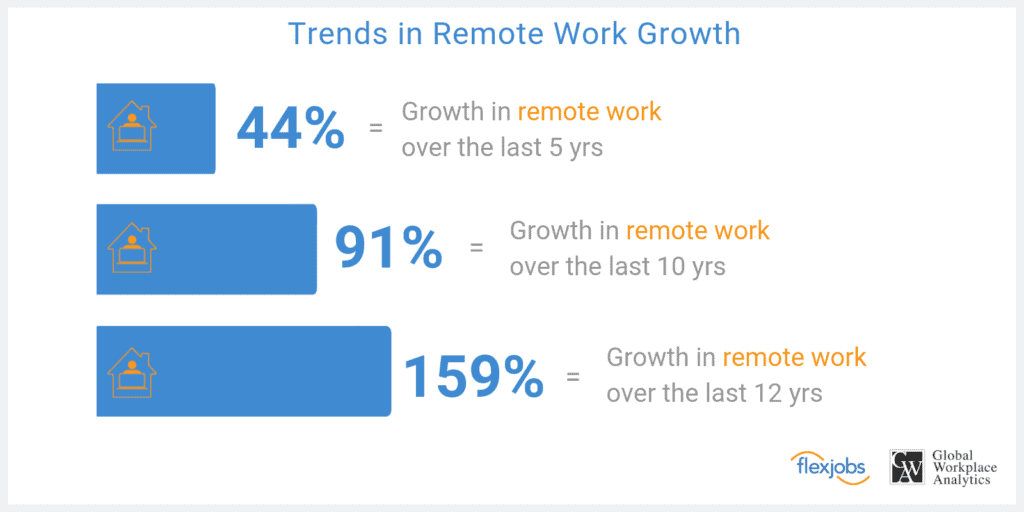
(Images source: flexjobs.com)
Today, according to the latest figures from Global Workplace Analytics (GWA), approximately 5 million US employees (3.6% of the workforce) work from home at least half the week.
That figure shoots up to nearly two-thirds (62%), however, when factoring in employees who work from home at any frequency, according to the State of Remote Work 2019 report from Owl Labs. That frequency does vary considerably, however.
Owl Labs found that of the 62% of respondents who work remotely, 87% do so at least once per month, 77% at least once per week, while 49% of them work remotely full-time.
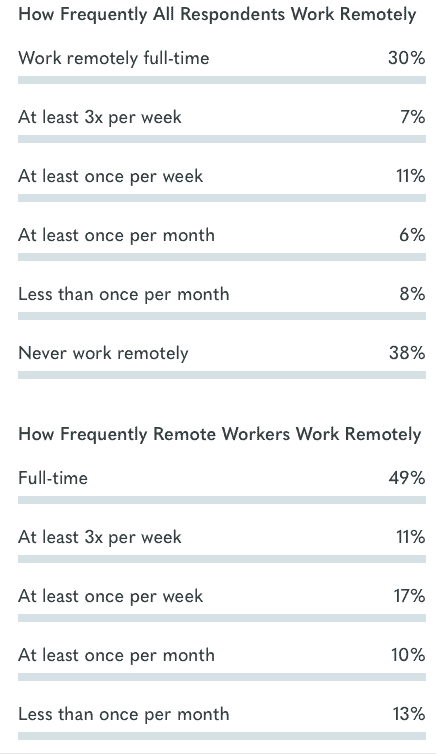
(Image source: owllabs.com)
By industry, perhaps unsurprisingly, the professional, scientific and technical services sector has the highest share of remote workers (12%), followed by the information industry (10%), and then finance and insurance (9%). These sectors are naturally more conducive to remote work than industries that require an onsite manual workforce like mining, quarrying, and oil and gas extraction (2%), for example, or construction (3%).
Global Workplace Analytics provides the following chart showing the percentage of people who work from home by industry.
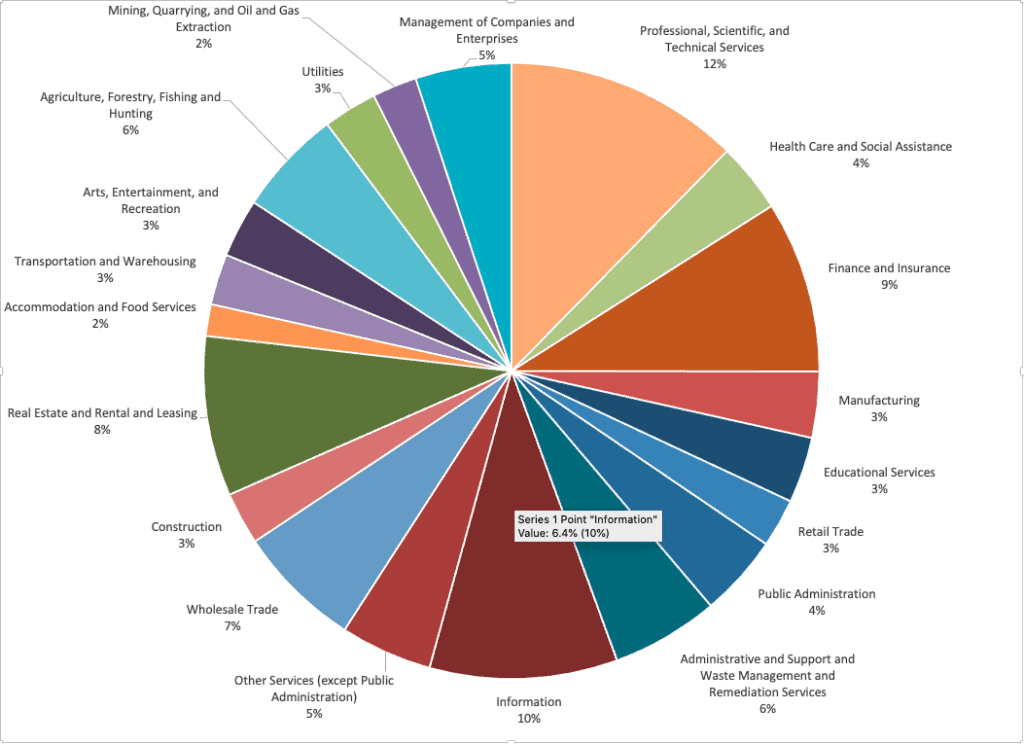
(Image source: globalworkplaceanalytics.com)
Employees Desire Telecommuting Option
A large part of the reason behind the rising trend in remote work is employee demand. Buffer recently published its own State of Remote Work 2019 report, for which nearly 2,500 remote workers were surveyed to find out both the benefits and struggles that come with telecommuting.
One of the most striking findings of the study was that nearly all respondents (99%) said that they would like to work at least some of the time remotely for the rest of their careers. As Buffer’s researchers point out, “This is a notable statistic to have discovered; while remote work is sometimes portrayed as a trend, these results seem to infer that this way of working is here to stay. Out of all the data we collected, no response was as powerful as this one.”
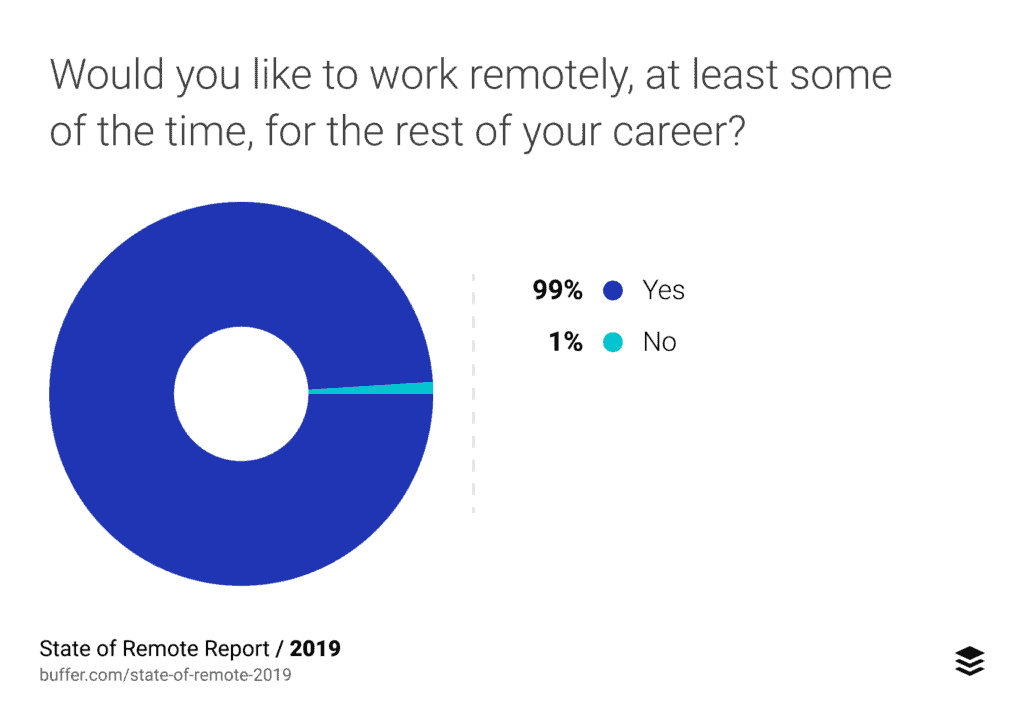
(Image source: buffer.com)
Why so powerful? Well, it seems that employees crave above all else the flexibility that remote work offers. 40% of respondents rated having a flexible schedule as the most significant benefit of working remotely. According to Iwo Szapar, CEO and Co-Founder of Remote-how – an online platform empowering the growth of remote work through education and community – workers enjoy this flexibility because they increasingly “value meaningful experiences more than possessions, and they want to be able to pay attention to all the important aspects of their lives.” And this especially true for younger generations, he says.
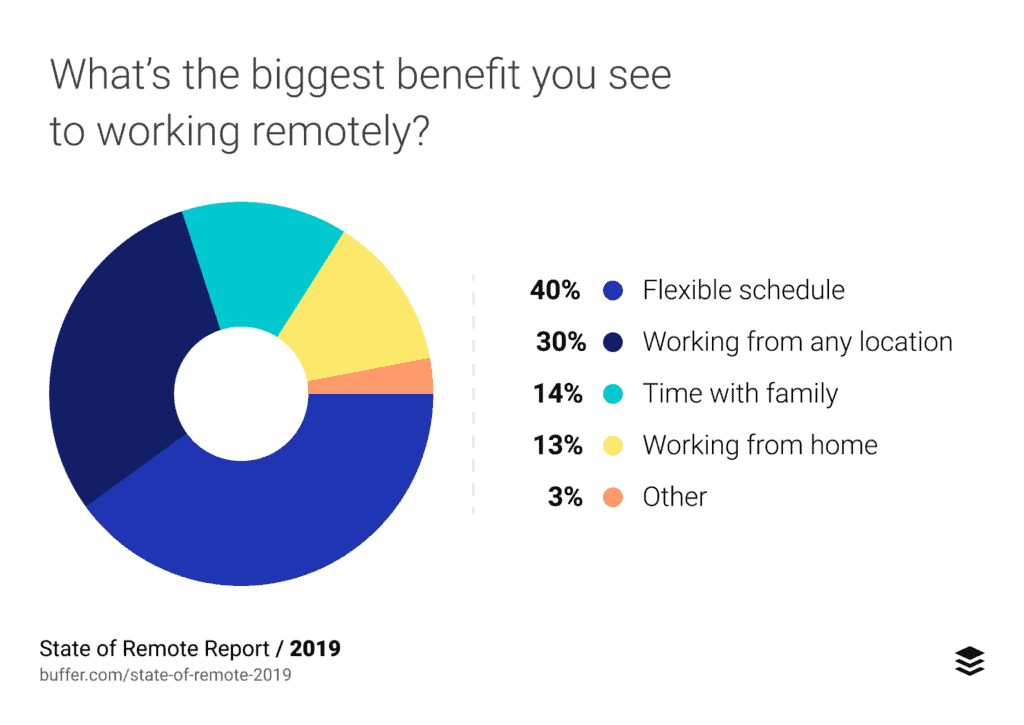
(Image source: buffer.com)
Owl Labs’ survey reveals further reasons employees are keen on the remote work option. Among other findings, the data reveals that having the ability to work remotely makes employees happier (83%), feel more trusted (82%), and better able to achieve work-life balance (81%). 71% also said that it would make them more likely to choose one employer over another in their next job – and 78% would even be happy to take a pay cut in exchange for the remote work privilege.

(Image source: owllabs.com)
How Do Employers Benefit from Working from Home (WFH)?
Aside from improving employee happiness, loyalty, and retention, employers can also benefit from huge savings by implementing a remote work program. In fact, GWA estimates that a typical employer can save an average of $11,000 per half-time telecommuter per year.
The primary savings say GWA is the result of increased productivity, lower real estate costs, reduced absenteeism and turnover, and better disaster preparedness. (GWA provides a free Telework Savings Calculator which employers can use to work out how much money they could potentially save by introducing teleworking.)

(Image source: globalworkplaceanalytics.com)
COVID-19 – The Tipping Point for Remote Work?
In a recent press release forecasting the impact of remote work on US businesses during the coronavirus pandemic, GWA President Kate Lister – one of the nation’s leading authorities on telework – predicts that work-from-home initiatives will save employers around the country billions every single day during COVID-19. “Over half of the workforce holds a job that could be done, at least partially, from home,” she says. “Being able to do so during the COVID-19 pandemic will collectively save US employers over $30 billion a day in what would have otherwise been lost productivity.”
Lister also anticipates that work-at-home adoption rates will increase after the crisis is over. “We predict that the longer people are required to work at home, the greater the adoption we will see when the dust settles. We believe, based on historical trends, that those who were working remotely before the pandemic, will increase their frequency after they are allowed to return to their offices. For those who were new to remote work until the pandemic, we believe there will be a significant upswing in their adoption. My best estimate is that we will see 25-30% of the workforce working at home on a multiple-days-a-week basis within the next two years.”
Why? There are a number of reasons, according to Lister. First, there will be reduced fear among managers and executives that they can’t trust employees to work untethered. Through being forced into the remote work situation, managers will see that their concerns about lost productivity are unfounded – especially as they, too, are forced to work from home themselves. “As they and their people get used to using virtual tools, their worries about not being able to collaborate are proven wrong,” writes Lister. “And they see for themselves just how much happier and engaged they are without the stress of commuting, being away from loved ones, workplace interruptions, etc.”
Second, there will be increased pressure for disaster preparedness. There is no doubt whatsoever that the disruption caused by the coronavirus will not be forgotten any time soon, forcing organizational leaders to make sure they are better prepared for the future.
Third, leaders will also be more aware of the cost-saving opportunities enabled by remote work. Lister cites occupancy studies that show just how inefficiently office space is currently being used. According to the data, employees around the globe are not at their desk 50% to 60% of the time – that’s a lot of money being wasted on unused real estate.
Fourth, as increasing focus on the climate puts more and more pressure on organizations to clean up their act, leaders will realize that remote work programs are a great way to improve their sustainability credentials. Already, after just a few weeks of reduced commuter travel, levels of air pollution and CO2 have dropped dramatically in some cities and regions. In New York, for example, carbon monoxide emissions, which mainly come from car exhausts, fell by 50% at one point earlier this month, according to researchers at Columbia University. The researchers also found that there was a 5% to 10% drop in CO2 over the city, as well as a significant drop in methane levels. “New York has had exceptionally high carbon monoxide numbers for the last year and a half,” said Prof Róisín Commane, from Columbia University, who carried out the New York air monitoring work. “And this is the cleanest I have ever seen it. It’s less than half of what we normally see in March.” Lister says that organizations will quickly realize that there is no easier, quicker, and cheaper way to reduce their carbon footprint than by reducing commuter travel.


(Image source: electrek.co)
Finally, COVID-19 will also reduce business travel, which may cause executives to rethink their need to travel to business meetings and conferences. “They will learn that while virtual meetings may not have all the same benefits of being face-to-face, the savings may outweigh the costs much of the time.”
In all, Lister and GWA believe that the pandemic may be the tipping point for remote work. Before the crisis, leading employers offered telecommuting options as a way to attract and retain talent and increase employee engagement – but programs were largely not formalized and only offered to select employees. Now that organizations are being forced into a position where enabling remote work is a necessity to continue with operations, leaders will realize that there are, in fact, many benefits and savings to be made from work-from-home initiatives, and that will likely drive increased adoption beyond the crisis.
Remote Work Challenges
Remote work may sound like the business revolution the world has been waiting for. However, it’s not something organizations can simply switch to and hope for the best. There are a number of challenges that businesses will need to overcome, policies and procedures to draw up, and technology to invest in.
Cybersecurity
As many businesses are quickly learning, employees working safely behind the robust cybersecurity systems of the office and employees working from home are two different kettles of fish – or rather phish. Already, opportunist cybercriminals are using the coronavirus to launch attacks targeting remote workers – with coronavirus-related phishing scams, in particular, emerging as a significant threat.
Such emails may be “dressed up” to appear as if they come from inside company ranks and contain information or instructions on what workers should do with regards to the outbreak – or any other work-related tasks for that matter. One phishing email targeting workplace email accounts, for example, was found to contain a malicious link supposedly to a “Communicable Disease Management Policy” issued by HR departments. By clicking on the link, however, the worker triggers a malware download.
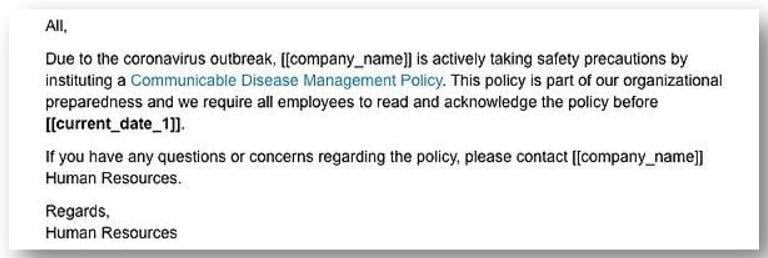
(Image source: norton.com)
Working from home will also likely mean that employees will have to rely on their personal devices – computers, smartphones, tablets, plus any internet access hardware – and their home networks to complete work tasks. The trouble here is that these will lack the robust cybersecurity tools that are already built into office networks, such as robust antivirus software, customized firewalls, and automatic online backup solutions.
These are all things that companies will have to consider very carefully before rolling out long-term work-from-home initiatives.
Managing Projects and Remote Collaboration
Aside from cybersecurity threats, other significant remote work challenges revolve around project management and collaboration between team members. Without having a physical presence, communication is more difficult, keeping track of individual tasks is complicated, and managers will need a way to make sure deadlines are met, and targets are hit.
Thankfully, this is 2020, and there are numerous tools available to help managers overcome pretty much any remote work challenge they encounter. From Slack, Trello, and Basecamp to Asana, Monday.com, and Zoom Videoconferencing – not to mention things like Google Drive and Microsoft OneDrive for document collaboration – efficient project management and remote collaboration can be easily achieved with the right suite of applications.
Challenges for Employees
While remote working has many perks, it’s not without its downsides from an employee perspective. Harking back to Buffer’s State of Remote Work 2019 report, remote workers experience a range of different struggles and challenges when working from home – the top three being unplugging after work (22%), loneliness (19%), and collaborating and/or communication (17%).
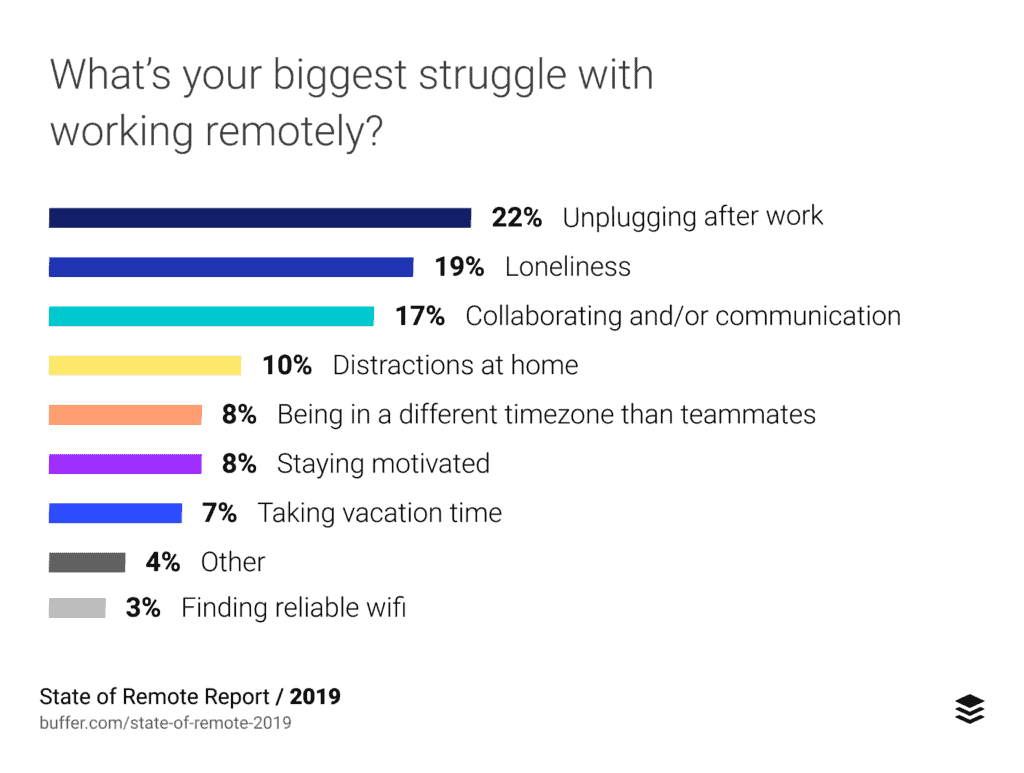
(Image source: buffer.com)
Buffer quotes Amir Salihefendic, CEO of Doist – the fully-remote company behind the task manager app Todoist – who, after seeing Buffer’s statistics, made the following comments. “Remote work isn’t just a different way to work – it’s a different way to live. And, unlike what you might see on Instagram, working remotely doesn’t mean you jet set to exotic locations to drink piña coladas on the beach. We need to acknowledge that isolation, anxiety, and depression are significant problems when working remotely, and we must figure out ways and systems to resolve these complex issues.”
Clear communication pathways are key to this. Collaboration and project management tools will, of course, help, but it’s important to maintain a sense of culture with your remote teams. When working from home, there’s no chance to have a quick chat and exchange a few laughs with colleagues around the coffee machine – so managers will need to make sure that everyone still feels they’re part of a team and not sentenced to hopeless isolation when working remotely. Facilitating live chat will enable remote employees to work together, converse, high-five, and enjoy a bit of banter while sitting at their desks – all of which is important for creating a culture in remote teams.
IT support and services company Conosco has got this nailed. More than half of its employees work remotely, and, according to CEO Anders Reeves, they are fully supported as part of the business. “We created OurCafe,” Reeves told ITPro. “Every Wednesday, in both London and South Africa, we down tools, sit in our respective boardrooms, and eat together. The webcams are open, and we’ve got this great banter and recognition, even though the teams are thousands of miles away. It’s like being in the pub or coffee shop for an hour a week, and if a client comes in, we can introduce them to the whole company, even though half of them are half a world away.”
Final Thoughts
The coronavirus outbreak may change the way – or rather the where – we work not just during the crisis, but for the long-term. With the right technology and team support in place, not only are remote work programs increasingly possible across a growing number of industries, but they’re also beneficial – for both employees and employers. Though there are, of course, a number of challenges to overcome, more and more companies have recognized the bottom-line benefits of telecommuting – even before COVID-19 – and are increasingly incorporating remote work initiatives into their business strategies. So, before summoning your entire workforce back into the office the moment the crisis is resolved, take a moment to mine your data and reflect on the experience, for it may very well be the case that remote work proves to be a more beneficial long-term option for everyone.
Summary:
Remote Work Trend
While COVID-19 may be creating a temporary spike in remote work, the truth is that telecommuting was already a growing trend – even before the pandemic struck. The question is, will this trend accelerate once we’ve defeated the virus? In February 2020, a special analysis by FlexJobs revealed a significant upward trend in remote work in the US over recent years. Between 2016 and 2017, remote work grew 7.9%. Over the previous five years, it grew 44%, and over the previous ten years, 91%. In all, between 2005 and 2017, there was a 159% increase. Today, according to the latest figures from Global Workplace Analytics (GWA), approximately 5 million US employees (3.6% of the workforce) work from home at least half the week. For more information on WFH types, best practices and more please visit www.itchronicles.com/what-is-wfh





